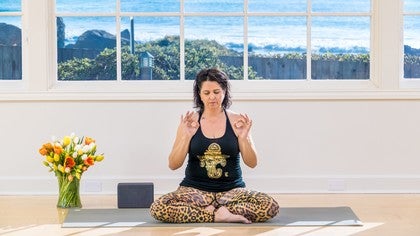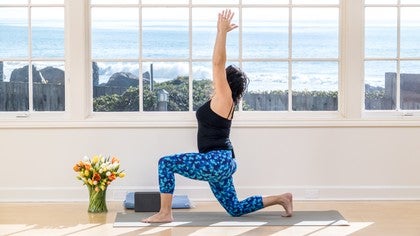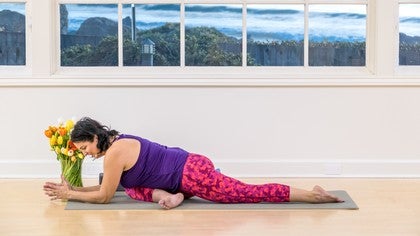Description
About This Video
Transcript
Read Full Transcript
Welcome, friends, to what, what is a mudra? So first, let's define what the word mudra means. The word mudra means to connect. Two things coming together and connecting. Or you could think of it as a seal, like an envelope ceiling, right?
There are body mudra, there are breathing mudra, and there are hasta mudra. Hasta means hand. So there are hasta mudra. And that's what I'm in love with. I love the hasta mudra.
So the history of mudra dates back thousands of years. You can look on the temples in India, from Tibet, China, Japan. There are always these beautiful hand positions, right? Most of them are spiritual mudra, right? Some of them are medicine.
They're like a type of medicine mudra. And that really, I love both. I want to talk to you a little bit about a spiritual mudra. And then throughout this season, we're going to investigate some mudra as well. So you already do mudra.
You may think you don't, but you do, because you go like this, hi. You go like this, right? You go like this, you go like this. There's some mudra I don't think I can do on film, right? When you're mad at somebody, there's that mudra, right?
You shoot the bird, you flip the bird. These are all cultural mudras for us. And in different countries, different countries have mudras as well. We have this mudra, right, in Italy. In Japan, this means come here, which is kind of strange.
It's like, come over here. But to us, it's like, hello or goodbye. So mudras are a part of who we are. We talk with our hands. I have some friends, and I'm a friend that if you tie my hands up, I might stutter a little bit.
Are you like that? If you're like that, then you're going to love, love, love the mudra, all right? So as I said before, mudra is like medicine. It's like you can give a prescription in a way of the mudra. We have mudra for back pain, mudra for feeling unwell, and maybe feeling unwell in the stomach, okay?
You could take. There's a mudra for that. There is a mudra for connecting with divinity. And that's the one that I really want to talk to you about, and the one that we're going to investigate today so that you can get a little bit of an idea of it. So how did these things come about?
Well, through time, the yogis realized that certain positions of the hands affected certain positions and placements and things in the body. Wow, this particular mudra, this is Prithivi mudra. This mudra seemed to help with the liver and the gallbladder. It seemed to create a sense of ease and balance, hmm, right? So they started investigating those, and scientifically, the way that it works is our nervous system coming off of the spine, it goes somewhere, it doesn't loop back around, right?
It ends in the feet, it ends in the hands, and it ends in the ears. So when we affect the feet, which is perfectly great in the asana practice, right? We are affecting certain parts of our body. When we are affecting the ears, the same, and the hands the same, but the hands are especially sensitive, because we naturally have so much dexterity in our hands. Speaking of dexterity, if you don't have dexterity in your hands, the mudra will help to generate more flexibility in your hands, it's really amazing.
So if you've had an injury, or if age is starting to change the way that your hands work, the mudra will, it will reverse time, it will reverse the injury and bring you back to a state of health, right? So let me show you Chan mudra. First let me show you the hand, I'm going to have you do something really cool. So here's your hand, so just put your hand up like this, there's your hand, there's your thumb, and your fingers, and they're all spread. And then flip your hand around and look at your palm, and for a moment just gaze at your palm.
My hands are so beautiful. So you're looking at your palm, you look at your thumb, move your thumb around, move each finger individually, and if you find this is difficult, this is a great place to start with your mudra practice. So you did one hand, maybe some of you are already doing both hands, do the other hand. Just getting a feel of your fingers, and noticing how they behave. Do you notice that when you move one finger, maybe some other fingers move along, it can't move independently.
It knows how to move independently, it just has to practice, right? So Chan mudra, let me show you Chan mudra. Now depending on how your hands are placed, if your hands are up, it's called something else, it's called Yana mudra. If your hands are down, it's called Chan mudra. You get to choose, that energetically you're really at first depending on what feels right.
And there's another interesting thing about the mudra, I just think it's so cool. When you initially start to do the mudra, your hands are going to get tired. Sometimes the nervous system itself, you're affecting these nerves, and those channels are being strengthened and deepened, and sometimes you might even get a chill, or feel achy. Just like it is when you take medicine, right? The medicine's working, it's helping you, but it's having its effect, and the body's not used to it.
So back to Chan mudra. So the thumb, your thumb is the representation of divinity, how cool is that? So check your thumbs out, yeah, there they are. That's God when it comes to the hand mudra. Your index finger is a representation of your soul, the soul of man, the soul of woman.
And we know that to be true, because if somebody says, hey, whose dog is this, you're like, it's mine. You immediately, you don't go, rarely. You go like this, right? You go, it's mine, oh, that's my dog, sorry, bring it over here, right? So when you're bringing these two together, when you're bringing the mudra together, the thumb coming together with the index finger, you're making a conscious decision to connect.
And check this out, open your hands, look at your hands. Now without moving your fingers, I want you to try to get your thumb to touch the other fingertips. Don't move the other fingers. You got to keep them nice and straight. The thumb tip can't get to the fingertips, right?
Try both sides, just in case you have a wacky other hand. Okay, now extend the thumb out. Take your index finger and try to touch the thumb tip without moving the thumb. You can't, you can't do it, can you, right? Guess what that means?
Like in a very deep spiritual level, it means for you to connect with the divine, you have to move toward the divine. And as you move toward the divine, the divine is going to move towards you. That is the spiritual teaching of the same position. You move toward God and God will move back towards you. So you take this position, you rest your hands on your lap, just like this.
Now if you rest your hands way out here, you're going to feel tired over time. It's harder to sit up, even if you're leaning against something. So the first suggestion is to draw the hands back so the shoulder drops, the elbow drops right out of the shoulder, just like that, right? Feel how comfortable that is? Sometimes the arm position and the lap is different.
If you're sitting in a chair, it's different. That's when you want to get your block. You take that block, you set it in your lap, and it gives a landing place for your hands. And then you can rest the shoulder. The heart can still have its space, right?
It's not getting collapsed, just like this. Either is fine. Hands are resting. Let your eyes close. And for a moment, you're feeling tip to tip, the tip of the thumb to the tip of that index finger.
And it's a very light pressure, right? It's a light pressure. I don't think that if we met the divine on the street, he would smash us, right? I think it would be a very beautiful interaction. So don't smash the fingers.
Very light. As though a butterfly wing. I say this at the studio all the time. As though a butterfly wing is in between your two fingers, and you could let the butterfly go and it wouldn't be harmed. Because the idea is connection, not force.
So your eyes are still closed, you're still feeling that beautiful long spine, that quiet pelvis. Enter your focus and attention just on the connection of that index finger and the thumb. Now the mudra, the effect of the mudra can be almost instantaneous. If you're having trouble closing your eyes, that's kind of common. If your eyes are fluttering and you're trying to keep them closed, go ahead and open them.
Keep the eyes feeling like they're dropping back, stare down at the floor, and don't focus on anything. So you can allow the eyes to be open. It's just a part of the healing process, it's okay, you go ahead and do that. Also if you feel like the hands need to be placed down, that's fine, do that as well. Initially with the mudra, we're looking to feel steady in the mudra.
So if you're feeling unsteady, it's going to be hard for the medicine to really go in and work. Just a few more breaths, letting your intention of your mind be with the action you're taking, be with the mudra itself. This is a spiritual mudra, so connect. Now quietly let your eyes open, and to release the hands is also very quiet. Imagine the butterfly again, you're releasing it, you want to go really slowly to let the hands open.
And then you turn the palms down, and just rest the hands. Now if your hands got tired during that, it's fine to stop early, you just stop early. The tiredness is really a good sign, but it's sort of like the nervous system and the muscles are telling you they're fatigued. So you go ahead and stop, that's enough for that time. This mudra can be done several times a day.
I prefer it's in a quiet place where you can let the intention of the mind be with what the mudra is about. However, it can also be done in other ways. You can take this mudra when you're in a moment of difficulty, so that you're in an argument and you think, wow, I need to connect, I'm going to take the mudra while you're in the argument. It's very fascinating and it does work, because your intention is about connection, your intention is about bringing yourself to steadiness. Feel it one more time.
Notice how you feel. Maybe you feel a little sweaty, maybe you feel a little uncomfortable, it's okay, the mudra's working, it's working on you, it's good, it's to be celebrated. Maybe you feel really relaxed, that too is fine. There's always the option of leaning up against the wall too, if the back is already feeling tired. Do what you need to do to be able to use the mind's intention to connect in this way.
Feel what that feels like, and then let the hands unfurl. Bring the palms together to Anjali Mudra, right at your heart. And I thank you, namaste.
Yoga Alchemy
Comments
You need to be a subscriber to post a comment.
Please Log In or Create an Account to start your free trial.









